Top 10 Market Entry Strategy For Businesses To Know In 2025

Expanding into Vietnam requires a well-planned market entry strategy that reduces risks and ensures long-term growth. Many businesses struggle to choose the right market entry strategies for their goals, budget, and industry. This MOR Software’s guide will walk you through proven approaches and show how outsourcing can simplify your expansion into Vietnam in 2025.
What Is A Market Entry Strategy?
A market entry strategy is a structured plan that shows how your company will approach a new market. It defines the steps, resources, and methods needed to establish a presence and compete effectively.
This plan shapes key choices around product design, pricing models, distribution channels, and promotion tactics. Whether your focus is on a fresh market entry abroad or introducing new offerings in an existing region, the strategy must be aligned with local demands.
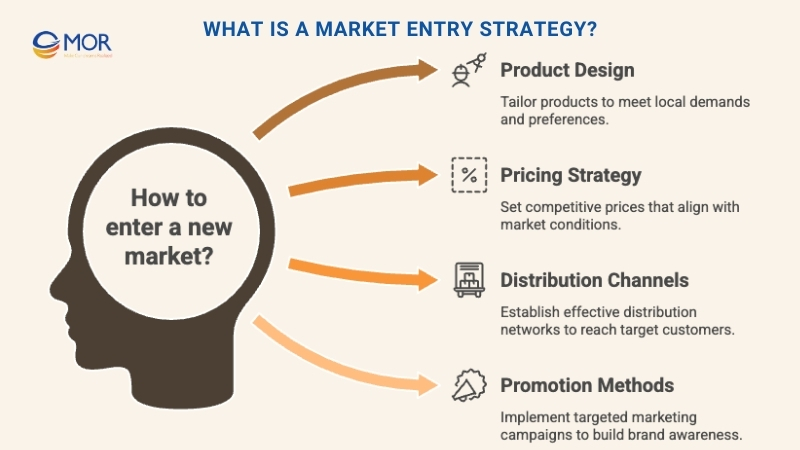
Building a strong market entry strategy requires careful research into customer behavior, competitor positioning, and regulatory requirements. The goal is to create a reliable foundation that allows your business to reach the right audience and communicate with impact from day one.
MOR Software supports global companies by providing technology outsourcing services in Vietnam, helping them design and execute strategies that reduce risks and accelerate success.
Why A Market Entry Strategy Shapes Long-Term Growth?
A market entry strategy is more than a roadmap for entering a market, it also defines how growth will be achieved after the first step. A carefully built plan becomes the base for scaling operations, reaching new customer groups, or adding product lines once you are established.
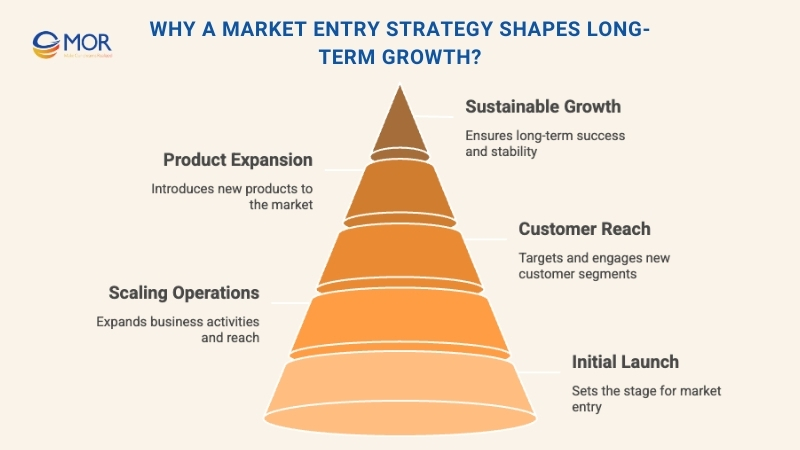
Companies can prepare not only for the initial launch but also for long-term expansion by adopting a clear business entry strategy. This forward view ensures that early investments lead to steady progress and lasting success.
Key Factors To Weigh Before Entering A Foreign Market
Pursuing a new market entry strategy can create clear competitive advantages for businesses, but success depends on choosing the right destination. Each region comes with unique conditions that may either support or challenge your growth.
To identify the best opportunities, companies must carefully assess the environment before committing resources.
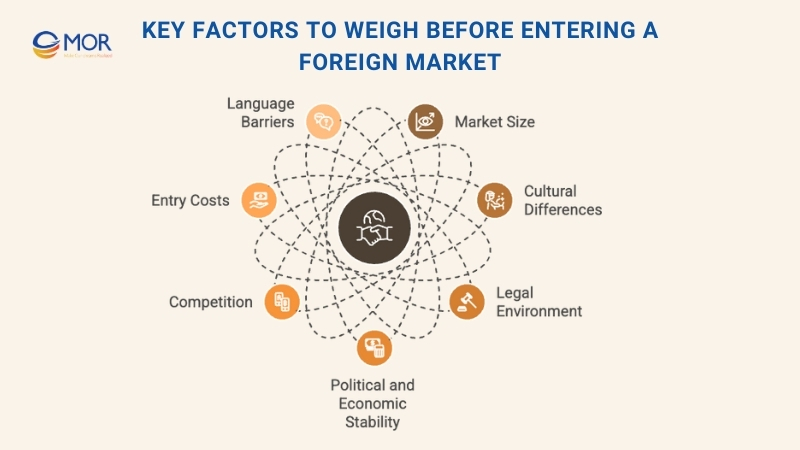
Here are several factors to review when building a market entry framework for foreign expansion:
- Market size and growth potential: The market should be large enough to justify investment and provide room for long-term gains.
- Cultural differences: Consumer expectations may differ greatly. Your ability to localize products, services, and communication will determine acceptance.
- Legal and regulatory environment: Transparent regulations, strong intellectual property rights, and clear procedures for setting up entities are all important for smooth operations.
- Economic and political stability: Markets facing unrest or high volatility may expose businesses to unnecessary risks. Stability supports predictable growth.
- Competitive landscape: Evaluate local rivals, their strengths, and where your company can stand out. Differentiation is key to capturing market share when doing business in Vietnam.
- Costs of market entry: Look beyond initial expenses to include ongoing costs of running and sustaining operations abroad.
- Language barriers: Communication gaps can slow adoption. Translation, multilingual websites, and tailored services can help reach local audiences.
Finally, every company must also define the right entry mode for expansion, which we will address in the following section.
TOP 10 Foreign Market Entry Strategies You Need To Know
Businesses exploring international growth can choose from several proven market entry strategies. Each option carries unique advantages and limitations, making it important to weigh them against your company’s resources, objectives, and target regions. Below are ten common approaches used worldwide.
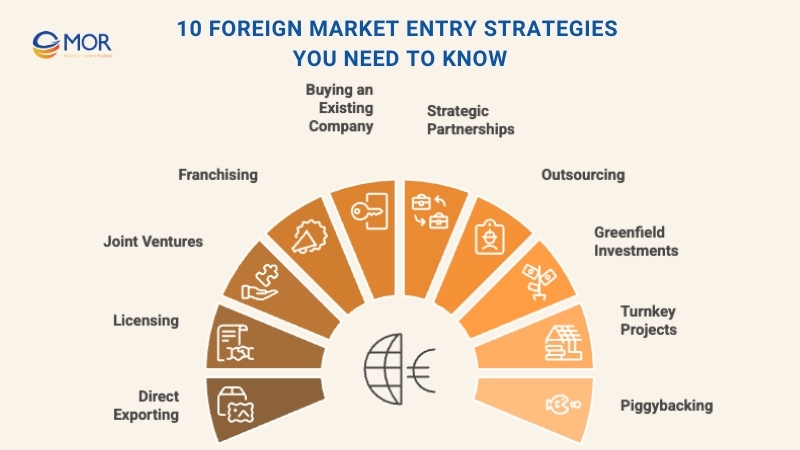
Direct Exporting
Direct exporting refers to selling products or services straight to buyers in a foreign market, often with the help of local agents or distributors.
For instance, in 2021 BMW shipped nearly 260,000 vehicles made in its South Carolina facility to more than 120 countries. Top destinations included China, Germany, South Korea, Canada, and the UK, showing how large-scale companies use this model to expand abroad.
Pros of Direct Exporting
Direct exporting allows you to maintain strong control over pricing, branding, and customer relationships in your chosen market. By managing the sales process directly, companies can keep their market entry strategies consistent across regions and deliver a unified brand experience.
This closer contact also provides valuable feedback that helps refine products and adjust offers to local preferences.
Cons of Direct Exporting
The challenge with this method is that companies handle everything themselves, from conducting local research to building distribution channels. These tasks can become costly and complex, especially without prior knowledge of the country’s regulations or customer behavior.
Licensing
Choosing licensing to set up company in Vietnam as a market entry strategy means granting a local company the rights to use or sell your intellectual property in return for royalty fees. This may cover brand assets such as logos, patents, or proprietary technology.
A well-known example is Nestlé’s 2018 agreement with Starbucks, which gave Nestlé perpetual rights to distribute and market Starbucks products across global markets. This arrangement expanded Starbucks’ reach while giving Nestlé a valuable new product line.
Pros of Licensing
Licensing lets you work with a partner who already understands the local market environment, government rules, and distribution networks. That partner also manages marketing, sales, and customer service on your behalf. This makes the entry strategy less costly and reduces risks compared to going alone.
Cons of Licensing
The drawback is limited control. Since sales are run by the licensee, your brand could suffer if they fail to deliver consistent quality or service. In addition, relying on another party may restrict how deeply your business can integrate into the market over the long term.
Joint Ventures
A joint venture is a market entry strategy where two or more companies partner to pursue a shared goal, often to help one party access a new market. In this arrangement, the partners agree to share both the risks and the rewards that come with the venture.
A clear example is the collaboration between Alibaba and Marriott International in 2017. Through this business entry strategy, Alibaba’s Fliggy travel platform and Marriott created a joint venture that allowed the hotel chain to expand its presence in China.
The partnership also gave Chinese travelers exclusive benefits when booking Marriott hotels worldwide, demonstrating how joint ventures can open doors to new customer groups.
Pros of Joint Ventures
Joint ventures give companies the chance to tap into local expertise and resources through their partners, making it easier to establish a presence in a new market. By combining strengths, both sides bring together technology, production capacity, capital, and market connections, which increases the likelihood of success for this market entry strategy.
Cons of Joint Ventures
Challenges often appear when partners aren’t aligned on roles, responsibilities, or expectations. Miscommunication can cause friction and, if unresolved, may shorten the life of the venture.
To avoid this, companies should agree on clear terms and responsibilities from the start, ensuring that the entrance strategy is supported by mutual understanding and shared objectives.
Franchising
Franchising as a market entry strategy involves inviting local businesses, or “franchisees,” to run your business model under your established brand name. In return, they pay fees that may include licensing rights to use trademarks and an ongoing share of their revenue.
A strong example is Subway, the U.S. sandwich chain that scaled globally by setting up franchises in different formats such as free-standing restaurants, drive-thrus, and inline outlets. This international market entry strategy helped Subway grow into one of the largest food brands worldwide.
Pros of Franchising
Franchising provides a relatively low-risk path to rapid expansion, as franchisees contribute their own funds to open and operate outlets. Since they handle most of the costs and risks, your company can grow faster with less direct financial exposure.
Franchisees also follow established processes and training programs, which means you can maintain consistency in brand standards, service, and customer experience.
Cons of Franchising
Expanding too quickly with many franchisees can backfire, leading to market oversaturation and weaker brand value. In some cases, franchisees may compete with each other for revenue in crowded areas, which can reduce profitability and even cause premature store closures.
Buying an Existing Company
Another market entry strategy is to acquire an established business in the target region and rebrand it as part of your operations. This approach allows you to bypass the long process of setting up from scratch.
There are two primary ways to pursue this route. A merger involves combining your business with another to create a new entity. An acquisition, on the other hand, means taking full ownership of the target company.
A notable case was Just Eat Takeaway.com acquiring GrubHub in the U.S., where the Dutch food delivery giant bought all of GrubHub’s shares to expand into the American market.
Pros of Buying an Existing Company
Purchasing a company offers instant market access along with its existing customer base, saving time and effort. This market entry strategy framework also eliminates a potential competitor if the acquired business operates in the same sector, strengthening your market share and improving your odds of success.
Cons of Buying an Existing Company
The challenge lies in integration. Differences in management styles, corporate culture, and operations can make merging or acquiring a business complicated and costly. Careful evaluation is required to avoid overpaying. A flawed assessment can turn the deal into a financial burden, making it harder to recover your investment.
Strategic Partnerships
In this market entry strategy, a company builds a long-term alliance with a local partner to pursue shared goals. Often, this means gaining access to the partner’s customer base and distribution channels, while offering them the chance to grow in your home market in return.
Unlike joint ventures, which are typically shorter-term and narrowly focused, strategic partnerships tend to last longer and cover broader collaboration.
For example, McLarens, a global insurance provider, formed a strategic alliance with Egypt Global Adjusters, making the latter its exclusive affiliate in Egypt and strengthening service delivery across the country.
Pros of Strategic Partnerships
Partnerships allow both businesses to share expertise, networks, and resources, making it easier for one party to establish a foothold in a new market. This mode of entry also spreads the risks, as partners carry responsibilities together.
Cons of Strategic Partnerships
The downside is that success depends heavily on alignment. A clash in culture, values, or goals may limit the partnership’s effectiveness. If the relationship breaks down early, the business may lose local support before securing a strong position in the market.
Outsourcing
Outsourcing as a market entry strategy means contracting another company to manage specific parts of your international operations. This often includes delegating sales, distribution, or customer support in the target market. Your business gains access to local expertise and infrastructure without needing to establish everything independently if you do so.
This approach fits well within a broader business entry strategy, as it allows companies to focus on their core strengths while reducing the costs of hiring and managing large in-market teams.
Although outsourcing to Vietnam reduces direct control over sales and customer interactions, many businesses accept this trade-off for faster market access and lower operating expenses.
Pros of Outsourcing
By outsourcing, businesses reduce labor and operational costs while benefiting from a partner’s expertise and established local presence. This entry mode allows for quicker scaling and efficient market access without needing a large on-the-ground team.
Cons of Outsourcing
The drawback is reduced oversight. Since a third party manages critical functions, businesses risk inconsistent brand representation or customer experiences. Overdependence on the outsourcing partner can also limit flexibility and weaken direct market control.
Greenfield Investments
A greenfield investment is a market entry strategy where a company establishes new operations in a foreign market from the ground up. These projects are usually managed under a wholly owned subsidiary of the parent company and give firms full ownership of their presence abroad.
For instance, in 2021, Siltronic, a German wafer manufacturer, announced plans for a greenfield project in Singapore by building a second 300 mm wafer fabrication plant to meet growing global demand. This move showed how companies use international market entry strategies to expand into new regions with high potential.
Pros of Greenfield Investments
The greatest advantage is control. By managing the operations directly, you oversee production, marketing, distribution, and quality assurance without relying on intermediaries.
Greenfield projects also let you adapt products and services to local needs quickly, avoiding delays that might occur when approvals from partners are required.
Cons of Greenfield Investments
Pursuing a greenfield investment as a market entry strategy often comes with significant risks and high upfront expenses. Since the business is built from scratch, companies must commit large amounts of capital while also navigating complex legal and regulatory requirements on their own.
Another challenge is the timeline. Establishing new facilities and operations can take years, meaning it may be a long wait before results begin to show. The extended setup period can delay returns, making this approach less appealing for businesses seeking faster market access.
Turnkey Projects
A turnkey project is a market entry strategy where a company hires a local contractor to design, build, and set up a facility on its behalf. Once completed, the contractor hands over a fully operational site, ready for the new owner to begin operations immediately.
For example, Saudi Aramco partnered with Weatherford International to deliver drilling and intervention services. Under this arrangement, Weatherford managed the entire process and committed to delivering dozens of wells per year, showcasing how turnkey projects can simplify expansion.
Pros of Turnkey Projects
With turnkey projects, most of the responsibility, planning, construction, and compliance, rests on the contractor. This lowers the commissioning company’s risk while speeding up the setup process.
The approach also allows firms to benefit from the contractor’s local expertise, making marketing strategies for new market entries easier to implement.
Cons of Turnkey Projects
The downside is dependence on the contractor’s reliability. If the contractor fails to deliver on time or quality, your entry into the new market may be delayed. In addition, while the facility may be operational at handover, the burden of running it and adapting to the local environment ultimately falls on your business.
Piggybacking on Local Networks
Piggybacking is a market entry strategy where a company relies on the established distribution channels or resources of a local partner to enter a foreign market. This often happens through partnerships or joint agreements, allowing businesses to expand without building everything from scratch.
One example is telecom operator Lebara, which used Mobily’s existing mobile network in Saudi Arabia to launch its services. The arrangement gave Lebara access to the market while also helping Mobily grow in a customer segment it had previously struggled to reach.
Pros of Piggybacking
Piggybacking lets companies leverage a partner’s existing infrastructure and expertise to reduce costs and speed up entry. It also provides instant access to distribution networks, customer relationships, and established brand trust in the region, making this entry strategy particularly effective for quicker expansion.
Cons of Piggybacking
The main drawback is reliance on the local partner. If their goals differ or they misuse the partnership, your brand may suffer. Misaligned distribution practices can damage your image and limit your ability to control how customers perceive your business in the new market.
Which Foreign Market Entry Strategy Should You Choose For Vietnam?
Out of the 10 options covered, the right market entry strategy depends on your goals, resources, and the specific conditions of the Vietnam market. Some companies may benefit from a single path, while others might succeed by combining multiple approaches.
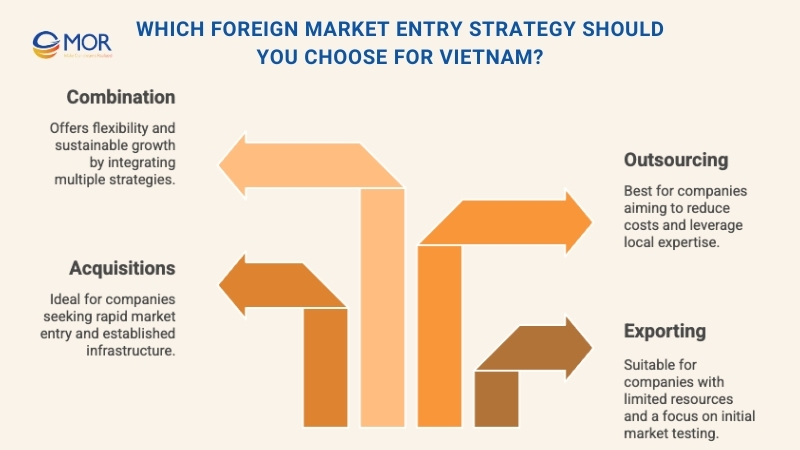
Whether through direct exporting, acquisitions, or outsourcing, businesses often mix methods to achieve sustainable growth. In fact, research on Australian SMEs revealed that many firms applied more than one market entry strategies when expanding abroad, showing that flexibility can be just as important as planning.
5 Steps to Build a Winning Market Entry Strategy With Outsourcing
Building a successful market entry strategy for Vietnam requires clarity, research, and careful execution. By using outsourcing as part of your plan, you can reduce risks while gaining access to local expertise. These five steps will help guide the process.
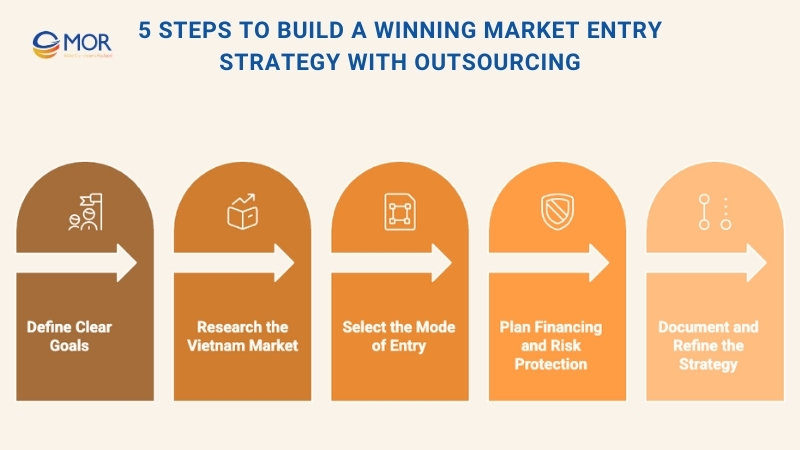
Step 1: Define Clear Goals
The first step is to decide exactly what you want to achieve. Lay out specific business objectives, expected sales, the products or services you’ll introduce, and the target market you’ll focus on. Include your action plan, timeline, budget, and resources. Setting measurable goals creates a solid starting point for your market entry.
Step 2: Research the Vietnam Market Thoroughly
Conduct in-depth research on Vietnam’s market conditions, consumer preferences, competition, and regulations. Look into cultural habits, demand trends, and the local business environment. This helps you shape your market entry framework and shows whether the chosen market can realistically support your growth.
Step 3: Select the Mode of Entry
Choosing the right path to enter Vietnam is key. Options may include working with local distributors, acquiring an existing company, forming partnerships, franchising, or setting up a direct presence. Some businesses may also rely on outsourcing to manage sales or operations. Each entry strategy should align with your resources and long-term goals.
Step 4: Plan Financing and Risk Protection
A strong market entry strategy framework considers financing and insurance. Map out how production, staffing, and shipping will affect cash flow, and secure financing early to avoid shortages. Companies should also consider credit or political risk insurance to safeguard against uncertainty when entering Vietnam.
Step 5: Document and Refine the Strategy
Put your plan into writing. A clear strategy document serves as a roadmap and helps gain buy-in from stakeholders. It also becomes a reference point for securing financing and creating a marketing plan. Regular reviews ensure your business entry strategy stays aligned with shifting conditions, allowing for updates and refinements over time.
MOR Software – Your Outsourcing Partner for Market Entry in Vietnam
When businesses build a market entry strategy for Vietnam, they need more than legal paperwork. Technology execution, IT outsourcing services, and a reliable partner on the ground are just as important. MOR Software fills this role by combining consulting with delivery.
We support international companies in four main ways:
- Market advisory and execution: We analyze industries, estimate costs, and recommend tailored technology solutions to match your expansion goals.
- Software outsourcing and talent: Our teams in Vietnam provide high-quality engineering services at competitive costs, with flexible scaling to match your business needs.
- End-to-end digital solutions: From web and mobile apps to AI, cloud, Salesforce consulting services, and enterprise systems, we build platforms that help you launch and grow quickly.
- Long-term support: We continue to manage operations, optimize expenses, and expand capacity so your Vietnam presence is stable and sustainable.
In short, MOR Software is both advisor and executor. We stand beside global businesses to make their Vietnam market entry strategy faster, safer, and more cost-effective.
Contact us today to explore how MOR Software can support your market expansion.
Conclusion
Choosing the right market entry strategy is the key to turning plans into measurable growth. Vietnam offers huge potential, but success depends on aligning your goals with the right approach, whether exporting, partnerships, or outsourcing. With MOR Software's local knowledge and skilled teams, we make market entry smoother, faster, and more sustainable. Contact us to start shaping your strategy today.
MOR SOFTWARE
Frequently Asked Questions (FAQs)
What is the market entry strategy?
A market entry strategy is a structured plan that defines how a business will enter a new market. It sets out objectives, describes the target market, details the products or services to be offered, projects potential sales, and explains the approach to achieving them.
What are the four market entry strategies with examples?
Companies can use various strategies to enter new markets. Common examples include exporting, licensing, franchising, partnerships, joint ventures, turnkey projects, and greenfield investments.
What is the market entry strategy framework?
The market entry framework provides a step-by-step process. It begins with evaluating the target market, then reviewing the company’s capabilities, analyzing resources against investment needs and expected returns, and finally, if the conditions are favorable, selecting the most suitable entry strategy.
How to write a market entry plan?
Building a market entry plan involves five steps. First, define clear goals. Next, identify target customer segments. Then, create relevant messaging and content. After that, design a brand experience across all stages of the funnel. Finally, measure success using the most relevant performance indicators.
What is the first market entry advantage?
The first-mover advantage is the benefit a company gains by being the first to introduce a product or service. This position allows the business to establish strong brand recognition and customer loyalty before competitors enter the market.
What are the 7 steps of marketing strategy with examples?
A marketing strategy can be built in seven steps: choose a project management tool, align marketing goals with overall company objectives, research the market, conduct a SWOT analysis, define the marketing mix, set a budget, and continually review and adjust the plan.
What are the 4 steps of marketing strategy?
The four main steps are: build awareness with branding, improve customer engagement, strengthen reputation, and drive business growth.
What are the four basic types of markets?
Market structure is grouped into four main types: perfect competition, monopolistic competition, oligopoly, and monopoly. Each is defined by the level of competition and control over pricing.
How to build a GTM strategy?
A go-to-market (GTM) strategy includes setting clear sales targets, creating timelines, identifying the product’s value proposition, defining the target customer, selecting performance metrics, reviewing past strategies, refining the sales process, and optimizing lead generation funnels.
What are the 5 international business strategies market entry mode?
There are multiple ways to enter global markets, including exporting, piggybacking, countertrade, licensing, joint ventures, establishing company ownership, franchising, and outsourcing.
Rate this article
0
over 5.0 based on 0 reviews
Your rating on this news:
Name
*Email
*Write your comment
*Send your comment
1